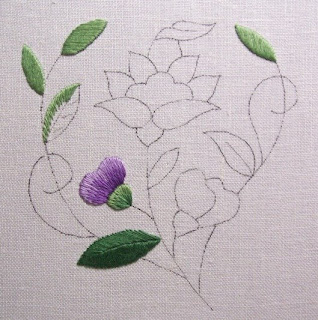
Direct from a hotel in Corning, NY, I present the pathetically minute amount of stitching from my class today! That's right, folks, I stitched a whopping three stones of the archway and a little bit of the hearth between the broom and Cinderella. Oh, and a doodle in the corner.
This class is turning out to be more challenging than I expected. Actually, I should say it's adaptable to the level of the stitcher. It's a beginning blackwork class, and can certainly be done as a copy of Marion's stitched piece. It can also be much more challenging - not in the stitching itself, but in the finding of appropriate patterns for each area.
Marion has provided 15 pages of various filling patterns. I'd guess there are over 200 patterns in all. (For the record, many, if not most, of these are NOT reversible. Blackwork does not have to be reversible.) We're finding patterns that are appropriate in scale to each area. We're then shading them by adding or deleting stitches, changing the color value of the thread, and/or changing thread thickness in some areas of the pattern. By clicking on the picture and looking at the three completed blocks in the archway, you can see a bit of this. The two larger blocks are in a lighter color and are missing some stitches. I'll probably use a similar effect on the inside and outside of the bucket.
In the hearth, I've stitched some basting lines. These will be used so I can tell when I want to change colors within that large area.
I'm going to learn a lot in this class. Most of my blackwork background has been with reversible bands (as in
Tiramisu). This is the first time I've worked with shading blackwork, and so far it's been a bit frustrating (like when I tried a pattern in a certain area only to find out it was far too big for that area, or when I tried to make a complex pattern reversible just to see if I could).
I just realized it. I've been doing a LOT with shading lately, between
Winds of Color and these two classes with Marion. Apparently, if last year was the year for goldwork, this year is the year for shading. There are three very different techniques: canvaswork, surface embroidery, and blackwork, but they all require
many decisions for shading. It's wonderful to know there's always something to learn in this fascinating needlework journey!
(Isn't it fun when a blog post doesn't end up the way you thought it would? This in itself is part of my journey - helping me find the parallels in my projects. I might not have made the "shading" connection without writing about it!)
 As you can see, I've been making good progress on Cinders. I'm looking forward to finishing the filling patterns so I can start the outlining. Right now, the blackwork sections all kind of blend together.
As you can see, I've been making good progress on Cinders. I'm looking forward to finishing the filling patterns so I can start the outlining. Right now, the blackwork sections all kind of blend together.








 The areas 13, 14, 14a, and 15, shown at right, are all examples of this open stitch shading. In area 13, only one color of thread and one type of stitch was used. The colored background makes the difference from one end of the area to the other. The same is true for area 14. In area 15, both the background and the thread value changed.
The areas 13, 14, 14a, and 15, shown at right, are all examples of this open stitch shading. In area 13, only one color of thread and one type of stitch was used. The colored background makes the difference from one end of the area to the other. The same is true for area 14. In area 15, both the background and the thread value changed.
